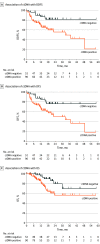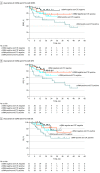Association of Circulating Tumor DNA and Circulating Tumor Cells After Neoadjuvant Chemotherapy With Disease Recurrence in Patients With Triple-Negative Breast Cancer: Preplanned Secondary Analysis of the BRE12-158 Randomized Clinical Trial
- PMID: 32644110
- PMCID: PMC7349081
- DOI: 10.1001/jamaoncol.2020.2295
Association of Circulating Tumor DNA and Circulating Tumor Cells After Neoadjuvant Chemotherapy With Disease Recurrence in Patients With Triple-Negative Breast Cancer: Preplanned Secondary Analysis of the BRE12-158 Randomized Clinical Trial
Abstract
Importance: A significant proportion of patients with early-stage triple-negative breast cancer (TNBC) are treated with neoadjuvant chemotherapy. Sequencing of circulating tumor DNA (ctDNA) after surgery, along with enumeration of circulating tumor cells (CTCs), may be used to detect minimal residual disease and assess which patients may experience disease recurrence.
Objective: To determine whether the presence of ctDNA and CTCs after neoadjuvant chemotherapy in patients with early-stage TNBC is independently associated with recurrence and clinical outcomes.
Design, setting, and participants: A preplanned secondary analysis was conducted from March 26, 2014, to December 18, 2018, using data from 196 female patients in BRE12-158, a phase 2 multicenter randomized clinical trial that randomized patients with early-stage TNBC who had residual disease after neoadjuvant chemotherapy to receive postneoadjuvant genomically directed therapy vs treatment of physician choice. Patients had blood samples collected for ctDNA and CTCs at time of treatment assignment; ctDNA analysis with survival was performed for 142 patients, and CTC analysis with survival was performed for 123 patients. Median clinical follow-up was 17.2 months (range, 0.3-58.3 months).
Interventions: Circulating tumor DNA was sequenced using the FoundationACT or FoundationOneLiquid Assay, and CTCs were enumerated using an epithelial cell adhesion molecule-based, positive-selection microfluidic device.
Main outcomes and measures: Primary outcomes were distant disease-free survival (DDFS), disease-free survival (DFS), and overall survival (OS).
Results: Among 196 female patients (mean [SD] age, 49.6 [11.1] years), detection of ctDNA was significantly associated with inferior DDFS (median DDFS, 32.5 months vs not reached; hazard ratio [HR], 2.99; 95% CI, 1.38-6.48; P = .006). At 24 months, DDFS probability was 56% for ctDNA-positive patients compared with 81% for ctDNA-negative patients. Detection of ctDNA was similarly associated with inferior DFS (HR, 2.67; 95% CI, 1.28-5.57; P = .009) and inferior OS (HR, 4.16; 95% CI,1.66-10.42; P = .002). The combination of ctDNA and CTCs provided additional information for increased sensitivity and discriminatory capacity. Patients who were ctDNA positive and CTC positive had significantly inferior DDFS compared with those who were ctDNA negative and CTC negative (median DDFS, 32.5 months vs not reached; HR, 5.29; 95% CI, 1.50-18.62; P = .009). At 24 months, DDFS probability was 52% for patients who were ctDNA positive and CTC positive compared with 89% for those who were ctDNA negative and CTC negative. Similar trends were observed for DFS (HR, 3.15; 95% CI, 1.07-9.27; P = .04) and OS (HR, 8.60; 95% CI, 1.78-41.47; P = .007).
Conclusions and relevance: In this preplanned secondary analysis of a randomized clinical trial, detection of ctDNA and CTCs in patients with early-stage TNBC after neoadjuvant chemotherapy was independently associated with disease recurrence, which represents an important stratification factor for future postneoadjuvant trials.
Trial registration: ClinicalTrials.gov Identifier: NCT02101385.
Conflict of interest statement
Figures


Comment in
-
Minimal Residual Disease in Patients With Nonmetastatic Triple-Negative Breast Cancer: Positive, Negative, or a More Complex Issue?JAMA Oncol. 2020 Sep 1;6(9):1332-1333. doi: 10.1001/jamaoncol.2020.2285. JAMA Oncol. 2020. PMID: 32644099 No abstract available.
References
Publication types
MeSH terms
Substances
Associated data
LinkOut - more resources
Full Text Sources
Other Literature Sources
Medical

